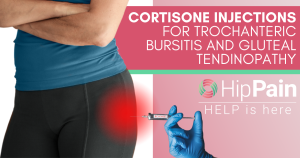Femoroacetabular impingement (FAI) refers to early contact (impingement) between the bones of the hip during movement. FAI is due to a variation in shape of the bones of the hip joint (thigh bone (femur) and/or hip socket (acetabulum)). This may result in reduced range of motion (stiffness) and, in a relatively small percentage of people, hip pain associated with extra forces being placed across the joint structures such as in the hip socket (acetabulum) including the labrum (a triangular fibrocartilaginous fringe that joins the edge of the hip socket important for hip joint health) and cartilage (tissue that covers and protects the ends of long bones at the joints) (Figure 1).
Painful FAI is referred to as Femoroacetabular Impingement Syndrome (FAIS). A published consensus of world experts¹ agreed that the diagnosis of FAIS requires 3 key features:
1. FAI bony variations observable on XRay or MRI Scans
2. Hip or groin pain related to particular motions or positions
3. Pain and restricted range of motion on clinical tests performed by a health professional



 3 different bony shape configurations, or morphology (meaning shape) types, may be associated with FAI – Cam, Pincer and Mixed
3 different bony shape configurations, or morphology (meaning shape) types, may be associated with FAI – Cam, Pincer and Mixed

 Key Point: Variations in bone shape on imaging do not necessarily correspond with pain or FAI symptoms, meaning you can have the bone shape variations and no pain². Up to 67% of people have been reported to have FAI bone variations on imaging but do not have any symptoms³.
Key Point: Variations in bone shape on imaging do not necessarily correspond with pain or FAI symptoms, meaning you can have the bone shape variations and no pain². Up to 67% of people have been reported to have FAI bone variations on imaging but do not have any symptoms³.
 High exposure to twisting and bending forces across the femoral neck
High exposure to twisting and bending forces across the femoral neck
 Considering the available evidence, a trial of non-surgical care for 3-6 months, with excellent adherence to the specific advice and prescribed exercise program is recommended before considering a surgical intervention. In some circumstances, earlier progression to surgery may be recommended but there are currently no clear guidelines as to who should consider an early surgical option.
Considering the available evidence, a trial of non-surgical care for 3-6 months, with excellent adherence to the specific advice and prescribed exercise program is recommended before considering a surgical intervention. In some circumstances, earlier progression to surgery may be recommended but there are currently no clear guidelines as to who should consider an early surgical option.



